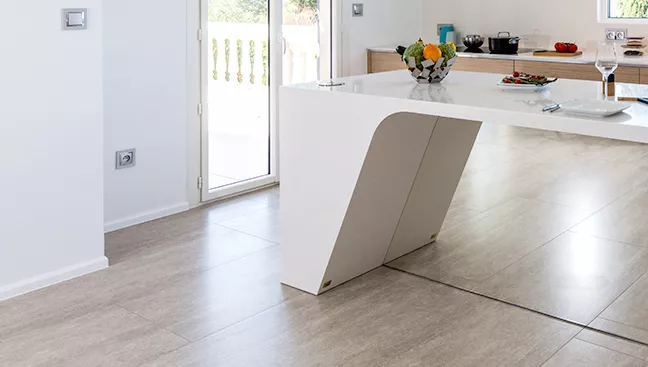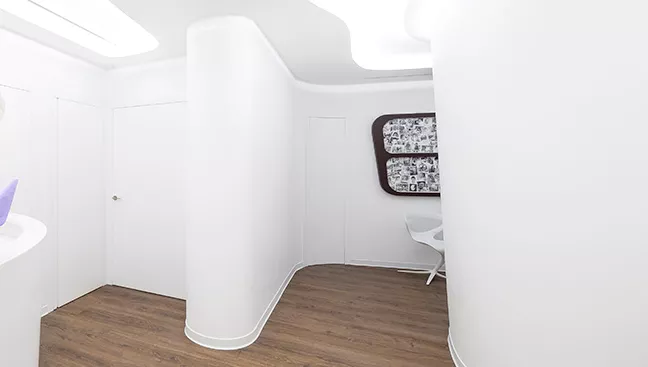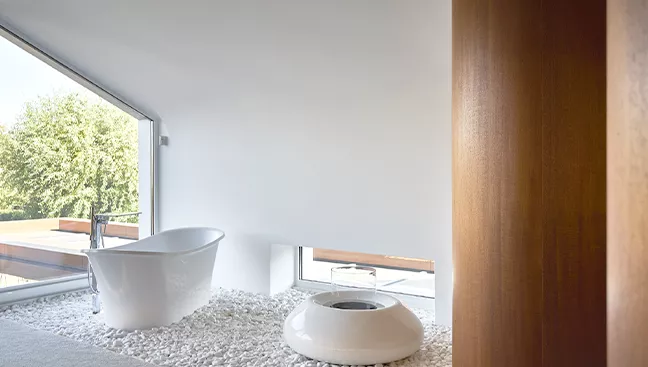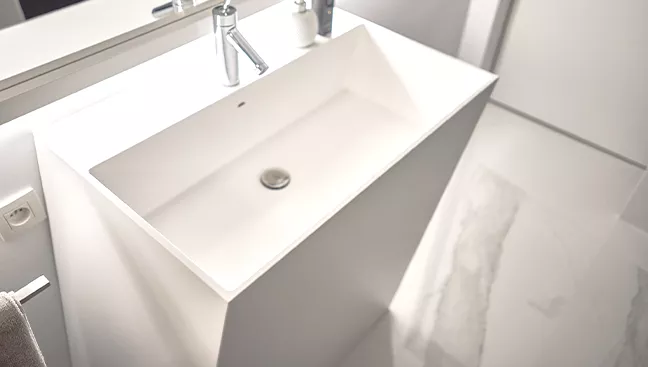Sign up for our newsletter to stay up to date with
the latest HFLOR/HIMACS design trends and news.

QUALITY MANAGEMENT
Quality Management Process
We are promoting a consistent quality management system from the customer’s perspective from the product planning stage to the service stage. It establishes and operates a warranty system to reflect customer complaints and needs by process and to verify quality from a customer's perspective. We continue to complement our core infrastructure to implement consistent quality strategies.
Operation of our Integrated Quality Information Management System
LX Hausys established an IT system in order to control and verify the quality of our complete products, such that the development of a new product or changes in the production of a product, including changes to its raw materials, equipment, and processing, do not affect product quality. Accordingly, we are able to ensure consistent product quality for our customers. Furthermore, in the event of a customer complaint about a product, we collect and manage all the related quality information in order to trace a product’s raw materials, production history, and processing condition, and then use this information to improve product quality by continuously investing in IT and facilities. We are strengthening our fundamentals in terms of production quality management by gradually applying MES1) and UMS2). We are also striving to improve the exterior quality of our products by reflecting a `test automation system`, using various types of sensors, throughout our annual production tasks.
1)MES (Manufacturing Execution System) : A management system that controls the entire production process from product planning to production.
2)UMS (Utility Management System) : A real-time monitoring system for processing information regarding the condition and status of equipment.
Enhancement of our Quality Management System
Our construction supervision department ensures product quality and provides excellent and consistent construction services. It checks the quality level of each of our construction teams, and standardizes and disseminates excellent construction know-how to major construction sites around the country. We conduct supervision activities aimed at preventing serious mistakes during the construction of kitchens and bathrooms. In addition, once construction is complete, we check the finishing quality using a standard that is even higher than that of our customers. In addition, we continue to make our methods of supervision and our feedback processes more sophisticated, in addition to managing such processes systematically.
Fostering of Quality Experts
Our construction supervision department ensures product quality and provides excellent and consistent construction services. It checks the quality level of each of our construction teams, and standardizes and disseminates excellent construction know-how to major construction sites around the country. We conduct supervision activities aimed at preventing serious mistakes during the construction of kitchens and bathrooms. In addition, once construction is complete, we check the finishing quality using a standard that is even higher than that of our customers. In addition, we continue to make our methods of supervision and our feedback processes more sophisticated, in addition to managing such processes systematically.
Operation of our Construction Supervision Department
Our construction supervision department ensures product quality and provides excellent and consistent construction services. It checks the quality level of each of our construction teams, and standardizes and disseminates excellent construction know-how to major construction sites around the country. We conduct supervision activities aimed at preventing serious mistakes during the construction of kitchens and bathrooms. In addition, once construction is complete, we check the finishing quality using a standard that is even higher than that of our customers. In addition, we continue to make our methods of supervision and our feedback processes more sophisticated, in addition to managing such processes systematically.
Quality Management Flow
Quality Planning
- Quality strategy
- Establish long-term strategy
- Manage quality costs (Q-cost)
- Improve processes
- Quality audit
- Check whether processes are complied with
- Manage issues related to international certifications and regulations.
- Quality data analysis
- Monitor quality performance
- Trace and manage production information
RAW MATERIALSDevelopment (Design) Quality
- Q-Gate for new products
- Verify development quality
- Verify long-term reliability
- Verify harmful substances
- Check initial operational control
- Window Spec-in Q-Gate
ProcessingProductionQuality
- Quality test (IQA/OQA)1)
- Manage the quality of the production process
- Monitor equipment and working conditions.
- Verify changes in 4M2)
- Quality assessment / instruction for suppliers
- Sign agreements on quality tests.
- Manage test equipment and production facilities.
- Quality improvement meeting group
- Hold working-level meetings on quality
ProductsSupplier / Construction Quality
- Provide technical support for suppliers
- Evaluate suppliers and construction companies
- Provide education on construction methods
- Standardize construction
- Quality improvement meeting group
- Hold working-level meetings on construction quality
Quality in Use
- Analyze customer complaints
- Manage the quality
- speed, and kindness of our response to customer complaints
- Service quality
- Manage the speed of handling and satisfaction level
1) IQA (Incoming Quality Assurance): Quality assurance of incoming raw and minor materials. OQA (Outgoing Quality Assurance): Quality assurance of outgoing products.
2) 4Ms: Changing elements of the production process - Man, Material, Machine, Method
Quality management
Mandatory hazard check when developing new products
We require the verification of product hazards during the new product quality verification phase, and continuously check the emission of hazardous substances stating with base materials and up to the finished product. All newly developed products must pass this verification process without failure, and any production process suspected of generating toxic emissions is controlled via rejection of development completion approval. We will continue to manufacture safe products by blocking harmful substances at the source during the new product development phase.
Operating an IT system for the management of chemical substances
Preliminary review of chemical substances Since 2018, we have ensured systematic management of chemical substances throughout the entire product development process - from the product development phase to the environment and safety review, purchase, review, use, storage, and disposal. Accordingly, we continue to make improvements that enable our employees to work safely without being exposed to risk factors. In addition, in order to prevent the legal risks associated with the legally regulated chemical substances used in base materials, we have introduced a review process aimed at checking chemical substances regulated by environment & safety authorities before the purchase and utilization of base materials.
Operating dedicated teams under our research institute
Verifying long-term reliability We have developed an accelerated testing method and include this method in regular inspection items for verifying the safety and long-term quality of a product, and reflect the environment in which the customer will use the product in the product characteristics. We measure and accurately manage how long a given product that is exposed to a particular service environment for many years can maintain its quality, and make continuous improvements aimed at strengthening its durability. Analyzing hazardous substances We operate precision analysis facilities and professional personnel in order to increase the reliability of efforts to detect serious toxic substances, such as TVOC and HCHO, and to secure safety in terms of harmful substances that are not recognized as such and that may be detected during the process. We continuously monitor the hazardous substances emitted during the entire production process from the development phase to product release, as well as any hazardous substances that may be generated by unintended chemical reactions or unidentified pathways.
Operation of toxic substance analysis rooms at each plant
We have established hazardous substance analysis infrastructure (test equipment/inspector) at each of our domestic manufacturing plants and are constantly testing for the presence of major toxic substances such as TVOC and formaldehyde. All products are controlled according to stringent guidelines in accordance with legal standards, and all non-conforming products that exceed these standards are disposed of. Moreover, activities aimed at preventing the recurrence of issues are performed on the basis of a thorough causal analysis.
Acquisition of official certification for reduction of hazardous substances
We hold various product safety certifications according to the characteristics of our products, ranging from the domestic certifications “Eco Label”1) and HB Mark2) to OEKO-TEX3), a European textile product quality certification.
Operation of radon (radioactive material) test systems
Operation of radon (radioactive material) test systems In 2019, we installed a radon analyzer at each of our domestic plants, and tests are being performed on a regular basis. We emphasize customer safety first and foremost, and continuously actively respond to new toxic substances.
Securing the basis of tracking and managing causative agents
We have established a system for tracking a product’s manufacturing history, including base materials, working conditions, etc., by linking IT systems such as our production management system and our warehouse management system. Going forward, we will operate the tracking management system continuously in order to respond to unexpected toxic substance issues by accurately identifying their causes and estimating the extent of any damage.




